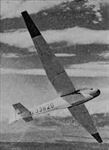
M.Hardy. Gliders & Sailplanes of the world
Briegleb BG 12
One of the USA's pioneer sailplane designers, William G. Briegleb built and flew his first glider as long ago as 1928, and later formed the Sailplane Corporation of America to market gliders of his own design. Just before World War 2 he produced the BG 6 and BG 7 strut-braced high wing designs with fabric-covered steel fuselages, the BG 6 being type-certificated in 1941; a few of these were used by the USAAF for training as well as by private owners and clubs. Recently Mr Briegleb's firm re-introduced construction of the BG 6 and BG 7 as a plans-only service to homebuilders, and by the beginning of 1978 59 sets of BG 6 plans and 29 sets of the BG 7 had been sold. The BG 12 is a single-seat high performance sailplane the sole prototype of which first flew in March 1956, and the basic design was intended especially for homebuilt construction in kit or plan form, kits and/or plans for a total of 257 BG 12s and 58 of the later BG 12-16 having been sold by early 1978; about 100 of these have been completed so far. All wing ribs and fuselage bulkheads are cut from plywood and construction is similar to that of a model aeroplane, with spruce longerons being covered with 1/8 in plywood. First production version was the BG 12A, first flown in July 1958, which had a three-piece cantilever wooden wing of 15% thickness/chord ratio and NACA 44-series section, the control system utilising aluminium tubes and castings. This was succeeded by the BG 12B, which first flew in July 1963 and had a two-piece wing with a thicker 18% section at the root, and a welded system of control linkages. The BG 12C was a Standard Class version with a span of exactly 15m instead of the 15.24m (50ft 0in) of the A and B, and this version also featured air brakes, the flaps being used as air brakes on the A and B models at speeds up to 130mph. Current production version is the BG 12BD, which first flew in July 1973 and reverts to the 15% wing root section of the A. On all versions, both ailerons and flaps are of wood and covered by 1/16 in plywood, while the tail unit is also of wood; the tailplane incidence can be adjusted on the ground and there are no tabs. The undercarriage consists of a fixed unsprung monowheel with a Briegleb circumferential brake, a shock-mounted nose skid and a spring tail skid. The pilot sits under a large one-piece moulded Plexiglas canopy and has an adjustable seat and rudder pedals.
Data: BG 12BD
Span: 49 ft 1 1/2 in
Length: 21 ft 11 in
Height: 4 ft 0 in
Wing area: 141 sq ft
Aspect ratio: 17.9
Empty weight: 500 lb
Max weight: 750 lb
Max speed: 140 mph (in smooth air)
Min sinking speed: 2.26 ft/sec at 47 mph
Best glide ratio: 33:1 at 52 mph
Briegleb BG 12-16
The BG 12-16 was developed from the single-seat BG 12BR, a special contest version of the BG 12 which was flown into seventh place in the 1964 US National Championships by Ross Briegleb. This later damaged its fuselage in a landing accident and was given a new fuselage originally built for the BG 16, a projected new design, thus becoming the BG 12-16 prototype; it made its first flight in this form in June 1969. The new low profile fuselage is slimmer than the BG 12's, with a glassfibre forward section containing the pilot in a semi-reclining seat under a two-piece canopy, the aft section of which is detachable; this tapers into a slim rear fuselage of circular section instead of the rectangular section of the BG 12's. A distinctive forward-swept fin and rudder is featured, and the all-flying tailplane, built in two halves, is of metal construction with glassfibre covering, and has two anti-balance servo tabs. The wing and its construction is similar to the BG 12's but with longer span flaps; the flaps, ailerons and rudder are built of ply-covered wood using spruce and Douglas fir. The undercarriage consists of a fixed unsprung monowheel, a shock-absorbing nose skid and a sprung tailwheel or tail skid. By the beginning of 1978 kits and/or plans for homebuilt construction of 58 BG 12-16s had been sold, although Mr William Briegleb has now retired from sailplane design and ceased all advertising.
Data :BG 12-16
Span: 50 ft 0 in
Length: 24 ft 0 in
Height: 4 ft 2 in
Wing area: 142.1 sqft
Aspect ratio: 17.9
Empty weight: 525 lb
Max weight: 850 lb
Max speed: 140 mph (in smooth air)
Min sinking speed: 2.23 ft/sec at 48 mph
Best glide ratio: 34:1 at 56 mph
- M.Hardy. Gliders & Sailplanes of the world
Фотографии
-
Jane's All the World Aircraft 1975 / 03 - Sailplanes
Регистрационный номер: N3362G [2] Briegleb BG 12 series single-seat Standard Class sailplane
-
Jane's All the World Aircraft 1976 / 03 - Sailplanes
Регистрационный номер: N3636G Briegleb BG 12A single-seat Standard Class sailplane
-
Jane's All the World Aircraft 1966 / 05 - Sailplanes
Briegleb BG 12B single-seat high-performance sailplane
-
Jane's All the World Aircraft 1964 / 03 - Sailplanes
Регистрационный номер: N3362G [2] Briegleb BG 12B single-seat sailplane
-
Jane's All the World Aircraft 1972 / 03 - Sailplanes
Briegleb BG 12B single-seat high-performance sailplane
-
Jane's All the World Aircraft 1976 / 03 - Sailplanes
Регистрационный номер: N86680 Briegleb BG 12-16 single-seat high-performance sailplane
-
Jane's All the World Aircraft 1975 / 03 - Sailplanes
Briegleb BG 12-16 single-seat sailplane, with all-flying horizontal tail
- Фотографии






